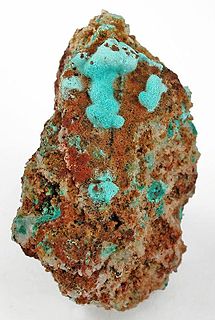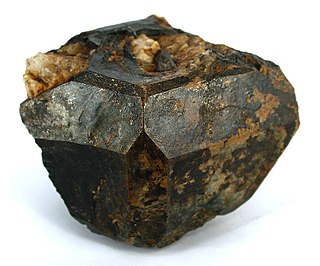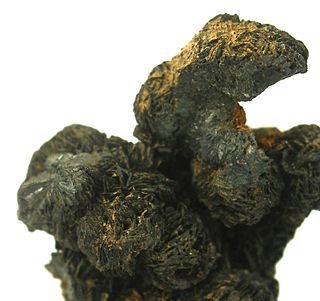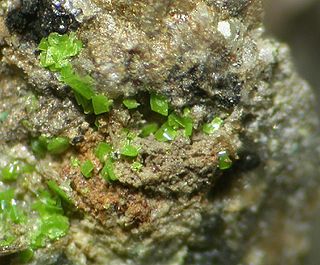Related Research Articles

Bornite, also known as peacock ore, is a sulfide mineral with chemical composition Cu5FeS4 that crystallizes in the orthorhombic system (pseudo-cubic).

Lithiophilite is a mineral containing the element lithium. It is lithium manganese(II) phosphate with chemical formula LiMnPO4. It occurs in pegmatites often associated with triphylite, the iron end member in a solid solution series. The mineral with intermediate composition is known as sicklerite and has the chemical formula Li(Mn,Fe)PO4). The name lithiophilite is derived from the Greek philos (φιλός) "friend," as lithiophilite is usually found with lithium.

Mixite is a rare copper bismuth arsenate mineral with formula: BiCu6(AsO4)3(OH)6·3(H2O). It crystallizes in the hexagonal crystal system typically occurring as radiating acicular prisms and massive encrustations. The color varies from white to various shades of green and blue. It has a Mohs hardness of 3.5 to 4 and a specific gravity of 3.8. It has an uneven fracture and a brilliant to adamantine luster.

Microlite was once known as a pale-yellow, reddish-brown, or black isometric mineral composed of sodium calcium tantalum oxide with a small amount of fluorine. Its chemical formula is(Na,Ca)2Ta2O6(O,OH,F). Today it is a name of a group of oxide minerals of a similar stoichiometry having tantalum prevailing over titanium and niobium. The microlite group belongs to a large pyrochlore supergroup that occurs in pegmatites and constitutes an ore of tantalum. It has a Mohs hardness of 5.5 and a variable specific gravity of 4.2 to 6.4. It occurs as disseminated microscopic subtranslucent to opaque octahedral crystals with a refractive index of 2.0 to 2.2. Microlite is also called djalmaite, but both names are now obsolete.
Mosesite is a very rare mineral found in few locations. It is a mercury mineral found as an accessory in deposits of mercury, often in conjunction with limestone. It is known to be found in the U.S. states of Texas and Nevada, and the Mexican states of Guerrero and Querétaro. It was named after Professor Alfred J. Moses (1859–1920) for his contributions to the field of mineralogy in discovering several minerals found alongside mosesite. The mineral itself is various shades of yellow and a high occurrence of spinel twinning. It becomes isotropic when heated to 186 °C (367 °F).
The sulfarsenide minerals are a subgroup of the sulfide minerals which include arsenic replacing sulfur as an anion in the formula. Antimony and bismuth may occur with or in place of the arsenic as in ullmannite. The chemical formula of a sulfarsenide looks like a sulfosalt, however the structures are distinctly different. In sulfosalts the arsenic replaces a metal ion.
Barbertonite is a magnesium chromium carbonate mineral with formula of [Mg6Cr2(OH)16CO3·4H2O]. It is polymorphous with the mineral stichtite and, along with stichtite, is an alteration product of chromite in serpentinite. Barbertonite has a close association with stichtite, chromite, and antigorite (Taylor et al., 1973). A study published in 2011 presented evidence that barbertonite is a polytype of stichite and should be discredited as a mineral species.

Hagendorfite is an iron phosphate mineral with the chemical formula of (Na,Ca)MnFe2(PO4)3 and is named after where the mineral was discovered, Hagendorf-Süd, Bavaria, Germany.

Roselite is a rare arsenate mineral with chemical formula: Ca2(Co,Mg)[AsO4]2·H2O. It was first described in 1825 for an occurrence in the Rappold mines of Schneeberg, Saxony, Germany and named by Armand Lévy after German mineralogist Gustav Rose. It occurs in cobalt bearing hydrothermal environments and was associated with veins of quartz and chalcedony in the type locality. It has also been reported from Italy, Morocco, Chile, British Columbia and several locations in Germany.

Parsonsite is a lead uranium phosphate mineral with chemical formula: Pb2(UO2)(PO4)2·2H2O. Parsonsite contains about 45% lead and 25% uranium. It forms elongated lathlike pseudo monoclinic crystals, radial spherulites, encrustations and powdery aggregates. It is of a light yellow colour. It has a Mohs hardness of 2.5-3 and a specific gravity of 5.72 - 6.29.

Hambergite (Be2BO3OH) is a beryllium borate mineral named after Swedish explorer and mineralogist Axel Hamberg (1863–1933). The mineral occurs as white or colorless orthorhombic crystals.

Messelite is a mineral with formula Ca2(Fe2+,Mn2+)(PO4)2·2H2O. It was discovered in Germany and described in 1890. The mineral was subsequently discredited in 1940, reinstated and named neomesselite in 1955, and the name restored to messelite in 1959.

Paramelaconite is a rare, black-colored copper(I,II) oxide mineral with formula CuI
2CuII
2O3 (or Cu4O3). It was discovered in the Copper Queen Mine in Bisbee, Arizona, about 1890. It was described in 1892 and more fully in 1941. Its name is derived from the Greek word for "near" and the similar mineral melaconite, now known as tenorite.
Georgius Agricola is considered the 'father of mineralogy'. Nicolas Steno founded the stratigraphy, the geology characterizes the rocks in each layer and the mineralogy characterizes the minerals in each rock. The chemical elements were discovered in identified minerals and with the help of the identified elements the mineral crystal structure could be described. One milestone was the discovery of the geometrical law of crystallization by René Just Haüy, a further development of the work by Nicolas Steno and Jean-Baptiste L. Romé de l'Isle. Important contributions came from some Saxon "Bergraths"/ Freiberg Mining Academy: Johann F. Henckel, Abraham Gottlob Werner and his students. Other milestones were the notion that metals are elements too and the periodic table of the elements by Dmitri Ivanovich Mendeleev. The overview of the organic bonds by Kekulé was necessary to understand the silicates, first refinements described by Bragg and Machatschki; and it was only possibly to understand a crystal structure with Dalton's atomic theory, the notion of atomic orbital and Goldschmidt's explanations. Specific gravity, streak and X-ray powder diffraction are quite specific for a Nickel-Strunz identifier. Nowadays, non-destructive electron microprobe analysis is used to get the empirical formula of a mineral. Finally, the International Zeolite Association (IZA) took care of the zeolite frameworks.

Marshite (CuI) is a naturally occurring isometric halide mineral with occasional silver (Ag) substitution for copper (Cu). Solid solution between the silver end-member miersite and the copper end-member marshite has been found in these minerals from deposits in Broken Hill, Australia. The mineral's name is derived from the person who first described it, an Australian mineral collector named Charles W. Marsh. Marsh drew attention to native copper iodide (Marshite) in the 1800s emphasizing its natural occurrence, it is not to be confused with copper (I) iodide a substance commonly synthesized in laboratory settings.
Charles Palache was an American mineralogist and crystallographer. In his time, he was one of the most important mineralogists in the United States.

Bieberite (CoSO4 · 7H2O) is a pinkish red colored sulfate mineral high in cobalt content. The name is derived from the type locality at the copper deposit in Bieber, Hesse, Germany. It has been described and reported as far back as the 1700s. Bieberite primarily occurs as a secondary mineral, forming in cobalt-bearing arsenide and sulfide deposits through oxidation.

Michael Fleischer was an American chemist and mineralogist. He worked as a geochemist with the U.S. Geological Survey from 1939 to 1978. He published a huge number of chemical abstracts and reviews of proposed mineral names, and is known for his authoritative Glossary of Mineral Species, first published in 1971.

Sengierite is a rare oxide and hydroxide mineral, chemically a copper and uranyl vanadate, belonging to the carnotite group. Its chemical formula is Cu2(OH)2[UO2|VO4]2·6H2O.
References
- 1 2 "Andrewsite: Andrewsite mineral information and data". www.mindat.org. Retrieved 2017-03-01.
- Maskelyne, N. S. (1871) Chemical News and Journal of Industrial Science, London: 24: 99.
- Maskelyne, N. S. (1875) 'On Andrewsite and Chalkosiderite' Journal of the Chemical Society , London: 28: 586-591
- Frondel, C. (1949) 'The Dufrenite Problem', American Mineralogist : 34: 513–540.
- Palache, C., Berman, H., & Frondel, C. (1951), The System of Mineralogy of James Dwight Dana and Edward Salisbury Dana , Yale University 1837–1892, Volume II. John Wiley and Sons, Inc., New York, 7th edition, revised and enlarged, 1124 pp.: 802–803.
- Dunn, Pete J. (1990), 'Andrewsite and laubmannite formally discredited', American Mineralogist 75, 1197-1199(1990)